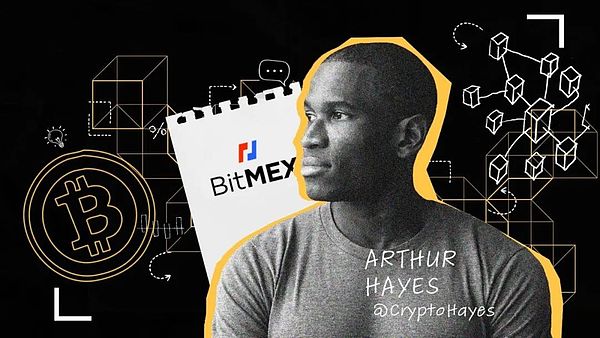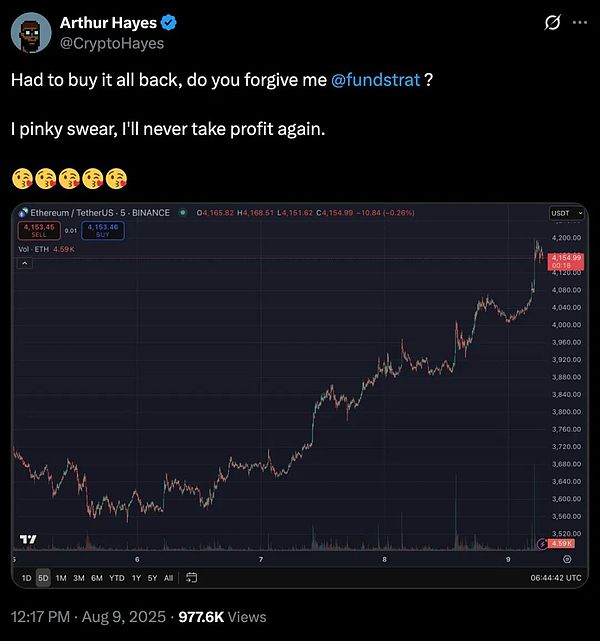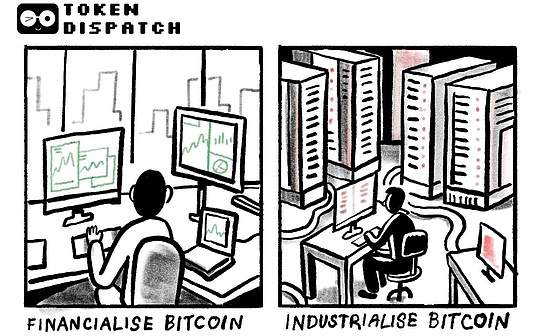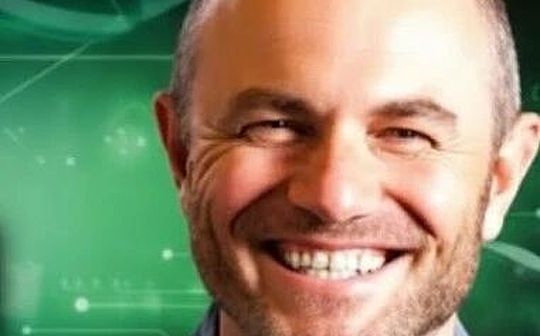
author:Thejaswini, source: Token Dispatch

Preface
Arthur Hayes travels with a suitcase full of plush toys.
The 40-year-old crypto billionaire has collected over 100 plush toys, named each and brought them with them as they celebrate the milestone.In his Miami apartment, where he had been under house arrest for six months, visitors can see rows of plush toys, like displays in his childhood bedroom: yellow-green starfish, foxes, armadillos, giraffes, elephants, octopus, snakes, and even anthropomorphic cabbage.
This may seem strange to those who have created the financial instruments that dominate cryptocurrency trading today.But Hayes was never a man of law.
In 2013, Bitcoin traders faced a problem that was both stupid and mathematically fascinating.
Each month their futures contracts expire, forcing them to constantly adjust their positions, like playing some expensive financial Sisyphus simulator.
Rolling contracts, paying fees, unlimited repetitions, gradually transferring all funds to the exchange through transaction costs.
Arthur Hayes, a derivatives trader who has been working on how to profit from the fact that the market is maintained by mathematical tape throughout his career at Deutsche Bank and Citigroup, saw this and came up with an idea that can only be described as extremely expensive.
“What if time didn’t exist?”
This is not the case in a philosophical sense—Hayes did not encounter an existence crisis about the nature of time reality.
He wondered what would happen if he could create a futures contract that never expired, eliminating the monthly fee withdrawal ceremony that was slowly bankrupting every bitcoin trader on the planet.
This answer made him a giant in the cryptocurrency space, creating the financial instrument that today supports most cryptocurrency transactions, but also ultimately faced federal criminal charges for building it without proper permission.
This story tells what happens when someone applies traditional financial engineering to a market designed by computer programmers who think regulation is just synonymous with “advice.”
Early life and education
Hayes grew up in Detroit in the 1980s, with both his parents working at General Motors, knowing that education is the only reliable way to get rid of the rise and fall cycles of the automotive industry.They moved to Buffalo and gave him a visit to Nichols School, a preparatory school where wealthy children learn Latin and poor students learn to build connections with the rich.
He ranked second in the class with excellent grades and was also a member of the school tennis team.After struggling between the University of Hong Kong and Wharton, he graduated in 2008 with a degree in economics and finance, just in time for the real-time collapse of the global financial system.
Instead of staying in New York to participate in the reflection on whether Wall Street was fundamentally broken after the crisis, he moved to Hong Kong.This is a prescient decision because in Hong Kong you can trade strange derivatives without anyone asking too much about sharp questions about systemic risks.
Learn derivative languages
A penniless intern, Hayes turned food delivery into a profitable business, charging a spread for colleagues per order and earning hundreds of dollars a week.When recruiters visited Wharton, they were impressed by taking them to nightclubs in Philadelphia.His dressing style at work is legendary—at a “College Friday” event, he wore a tight pink Polo shirt, pickled jeans and a pair of bright yellow sneakers, which made a department head ask, “Who is that guy?” This incident led to the cancellation of the “College Friday” event.
In 2008, Deutsche Bank hired Hayes as an equity derivatives trader in its Hong Kong office.There, Hayes was attracted by the complex mathematics of derivatives—the value of these financial instruments comes from underlying assets.
His expertise is delta-one trading and ETFs – the “pipeline engineering” in the financial world.Although not glamorous, it is crucial that you can make a profit if you know how to connect pipes.
He jumped to Citigroup in 2011 after three years of learning how to make money from the price difference of about seventeen seconds.In 2013, bank regulators decided to have fun, and Hayes was laid off, allowing him to discover it at the moment when Bitcoin needs people who know the fact that the financial pipeline actually works.
Bitcoin in 2013 was traded on an exchange built by developers who knew how to program blockchain protocols but had never heard of margin requirements.Hayes saw an all-weather operation without a circuit breaker mechanism, no central authority, and of course no complex risk management.It is either the future of finance or a complex way to lose quickly, and Hayes believes that the two possibilities are not mutually exclusive.
The infrastructure is rude but the mechanism is fascinating, but the underlying mechanism of the Bitcoin market fascinates Hayes.This market urgently needs the kind of financial engineering he learned in the traditional finance field.
Create BitMEX
Hayes worked with mathematician Ben Delo and Samuel Reed, who really understands the operation of cryptocurrencies.In January 2014, they began building BitMEX, a Bitcoin Merchant Exchange, claiming it was the “best peer-to-peer trading platform”, competing with exchanges that feature almost only “barely running.”
The three founders each have their own strengths: Hayes is proficient in market structure and derivatives, Delow can build complex trading engines, and Reed is well aware of cryptocurrency technology.
BitMEX was officially launched on November 24, 2014, focusing on Bitcoin derivatives.After months of careful development and stress testing, the timing was just right.When it went online, the founders were scattered around the world—Hayes and Delo were in Hong Kong, while Reed participated remotely from his honeymoon trip in Croatia.
Early products include leveraged Bitcoin contracts and dual-currency futures, allowing traders to express their views on Bitcoin prices without holding the underlying assets.These complex tools require understanding of margin, clearing mechanisms and cross-currency hedging.
But Hayes and his team have just begun.
On May 13, 2016, BitMEX launched the unprecedented XBTUSD perpetual swap contract.This is a never-terminated futures contract, where funds are paid between long and short positions, keeping the contract price stable with the Bitcoin spot price.The perpetual swap contract provides up to 100 times leverage and settled in Bitcoin cash.
Traditional futures expire monthly, forcing traders to keep rolling positions and paying fees, falling into a ridiculous cycle.Hayes borrowed the capital mechanism of the foreign exchange market and applied it to Bitcoin futures.The contract does not have an expiration date, but keeps the price pegged to the spot Bitcoin price through the payment of funds between long and short positions.When the contract price is higher than spot, the long pays the short; when it is lower than spot, the short pays the long.The market thus achieves self-correction.
This eliminates expiration dates, reduces transaction costs, and creates such a practical tool that every crypto exchange follows immediately.Today, perpetual swaps account for the majority of global crypto trading volume.Hayes actually solved the problem of time, at least in the derivatives contract space.

Explosive Growth and Regulatory Review
BitMEX’s XBTUSD contract quickly became the world’s most in-depth Bitcoin derivatives market.The exchange’s complex risk management, professional-grade tools and high leverage attract traditional financial and crypto-native traders.
By 2018, BitMEX had more than $1 billion in daily nominal trading volume.The exchange moved into the 45th floor of the Yangtze River Centre in Hong Kong – one of the most expensive office buildings in the city.In August 2018, BitMEX was shut down due to regular maintenance and the price of Bitcoin rose immediately, adding $10 billion in market cap to the entire crypto market.
BitMEX nominally bans U.S. customers, but critics believe these restrictions are easily circumvented.The impact of exchanges on Bitcoin prices has attracted the attention of academics, regulators and politicians who are just beginning to understand the cryptocurrency market.
In July 2019, economist Nouriel Roubini released a report hinting that BitMEX was involved in “systemic illegal conduct,” saying it allowed excessive risk and could profit from client liquidation.The allegations sparked regulatory investigations and congressional hearings on the structure of crypto markets.
By the end of 2019, the daily trading volume of Bitcoin derivatives reached between $5 billion and $10 billion, more than ten times the volume of spot Bitcoin transactions.BitMEX takes up a large share of this activity, making Hayes and his partners the central figures in the global crypto market.
On October 1, 2020, things took a sharp turn for the worse, the U.S. Commodity Futures Trading Commission (CFTC) filed a civil lawsuit, and the U.S. Department of Justice (DOJ) released criminal charges, saying that BitMEX operated as an unregistered futures commissioner while serving U.S. customers and ignored anti-money laundering requirements.Prosecutors believe Hayes and his partners deliberately ignore compliance requirements while making hundreds of millions of dollars in profits.
On the same day, Hayes resigned as CEO.Reed was arrested in Massachusetts.Hayes and Delow are listed as “on-flight,” a term for the Justice Department that means “we know where you are, but haven’t caught you yet.”
The legal lawsuit lasted for two years, during which time Hayes found himself good at writing articles about markets and monetary policy.His Crypto Trader Digest has become a must-read for understanding the link between macroeconomics, Federal Reserve policies and cryptocurrency prices.He established the framework to explain why central bank decisions inevitably pushed people toward Bitcoin.
In August 2021, BitMEX agreed to pay $100 million to settle the civil charges.On February 24, 2022, Hayes pleaded guilty to the charge of intentional failure to establish an anti-money laundering program.On May 20, 2022, he was sentenced to six months of home detention, two years of probation and a $10 million fine.
During the legal litigation, Hayes became one of the most insightful critics in the cryptocurrency space.His analysis of Federal Reserve policy and Bitcoin price dynamics has influenced traders and institutions’ perceptions of cryptocurrencies as macro assets.He proposed the concept of “NakaDollar”-A synthetic dollar generated by combining Bitcoin long positions with perpetual contract short positions effectively creates dollar exposure without traditional banking infrastructure.
Hayes also actively advocates Bitcoin as a hedge tool for currency depreciation.
“Our currency transfer is shifting from analog society to digital society, which will bring huge disruption,” Hayes observed.“I saw opportunities for bitcoin and cryptocurrencies to create a company that could benefit from this huge chaos transformation.”
On March 27, 2025, U.S. President Trump pardoned Hayes and his BitMEX co-founder, officially ending the defendant’s career.At this point, Hayes has started his post-BitMEX career as Chief Investment Officer of family office fund Maelstrom, which invests in venture capital, liquidity trading strategies and crypto infrastructure.
The fund supports Bitcoin development by providing $50,000 to $150,000 to Bitcoin developers, reflects Hayes’ belief that open source development requires sustainable funding.”Bitcoin is a cornerstone asset in the crypto space, and unlike other crypto projects, Bitcoin never raises funding for technology development through issuance,” the Maelstrom website explained.
Recent market trends
Hayes’ current investment strategy reflects his macro outlook.In August 2025, he made headlines for buying more than $15 million in cryptocurrencies in five days, focusing on Ethereum and DeFi tokens rather than Bitcoin.His purchases include 1750 ETH ($7.43 million), as well as a large holding of HYPE, ENA and LDO tokens.This configuration reflects his belief that certain altcoins can benefit from market conditions, such as institutional investors’ favoritism, the growing popularity of stablecoins, and agreements to earn profits by filling specific gaps in the market.
Hayes is also a staunch supporter of Ethena (ENA), a synthetic dollar agreement based on the derivative concept he pioneered at BitMEX.In August 2025, he purchased 3.1 million ENA tokens worth $2.48 million, becoming one of the largest individual holders of the project.Hayes sees Ethena as the next phase of the NakaDollar concept, leveraging derivatives to create dollar-pegged assets that do not require traditional banking infrastructure.This investment shows that Hayes is betting on a new generation of projects that use perpetual swaps and funding mechanisms to redefine the operation of synthetic assets.
Earlier that month, he sold $8.32 million in Ethereum when its price was close to $3,500, citing macroeconomic concerns.When ETH rebounded to over $4,150, he bought it again and admitted on social media: “I have to buy it all. I swear I will never get a profit again.”

Hayes’ current macro argument focuses on the currency printing he believes is inevitable for the Federal Reserve.He believes structural issues including housing market pressures, demographic changes and capital outflows will force policymakers to inject about $9 trillion into the financial system.”If you don’t print money, the system will crash,” he said, focusing on the debt burden of entities such as Fannie Mae and Freddie Mae.
If this scenario happens, Hayes predicts that by the end of 2025, Bitcoin could reach $250,000 as investors look for alternatives to depreciating fiat currencies.He also believes that Bitcoin could reach $1 million by 2028, based on his belief that the current monetary system is unsustainable and that Bitcoin is the most viable alternative to store of value.
Perpetual swaps have completely changed the way cryptocurrencies are traded by providing tools to eliminate many frictions in the early derivatives market.
In 2025, even mainstream platforms like Robinhood and Coinbase are launching their own perpetual products, while new exchanges like Hyperliquid build the entire business around Hayes’ original innovation.
The regulatory framework spawned by BitMEX cases also shapes industry standards.Proper anti-money laundering programs, customer verification and regulatory registration become essential requirements for exchanges serving the global market.
Hayes, 40, holds a unique position in the cryptocurrency ecosystem.He is old enough to remember the traditional finance before Bitcoin emerged; he is experienced enough to build the infrastructure that defines how cryptocurrency transactions are; he is also experienced enough to spend a safe life in rapid success and serious legal consequences.
His story shows that in the crypto space, sustained success requires a simultaneous understanding of technology and regulation, innovation and compliance.Perpetual swaps are successful not only because of their technical elegance, but also because it solves real problems for traders while operating within existing legal frameworks—at least before those frameworks catch up with innovation.
Reflecting on BitMEX’s experience, Hayes said: “We don’t need to ask for permission to build this platform, and what industry can have three guys try to build an exchange with a daily transaction volume of billions of dollars?”
This sentence captures the opportunity and responsibility to build financial infrastructure in a rapidly changing regulatory environment.
Today, Hayes continues to analyze the market and invest in a centralized manner based on his macro outlook, and his influence goes beyond a single transaction or investment.Through his writing, investment and continued participation in crypto markets, he remains one of the most thoughtful voices in the industry that often prioritizes hype over analysis.






